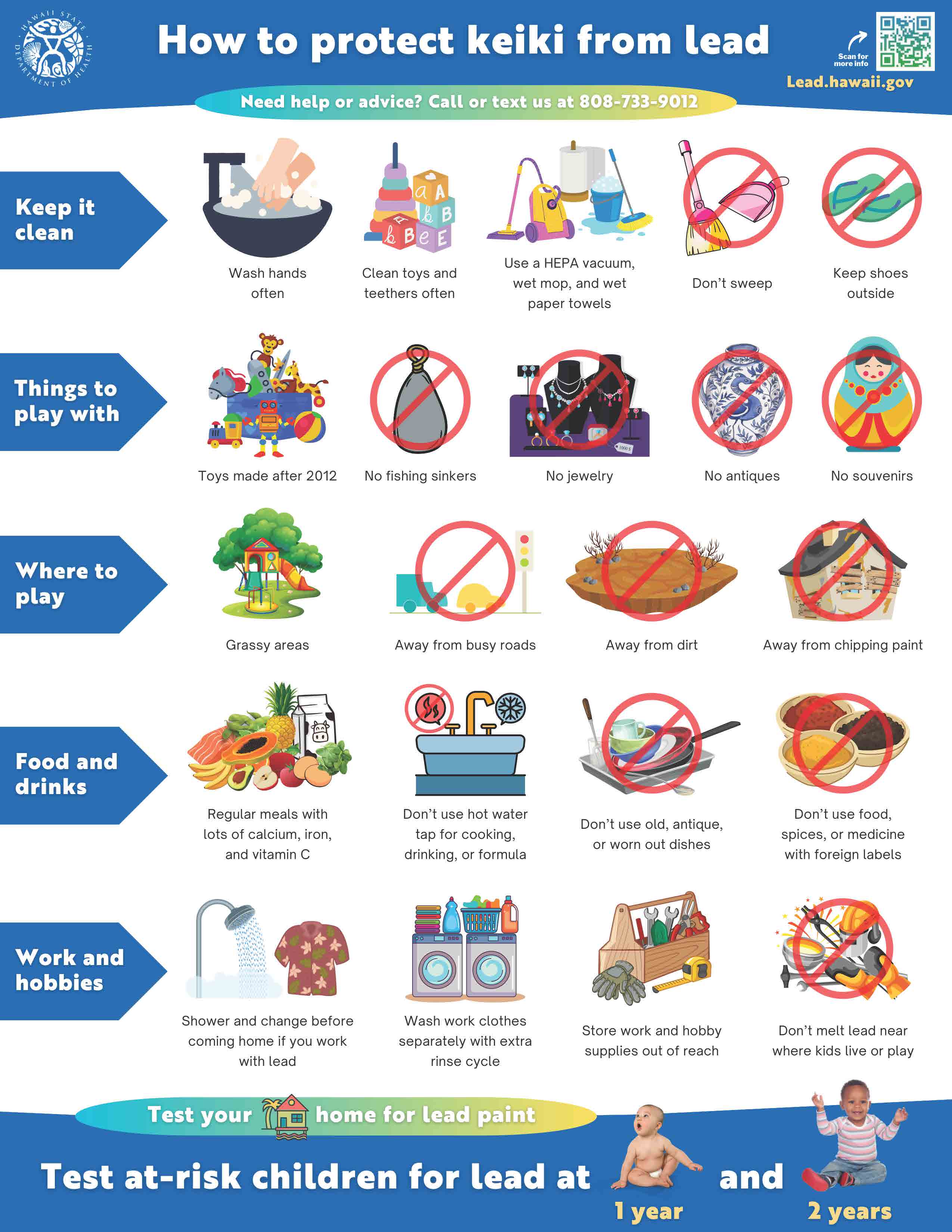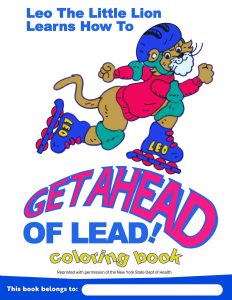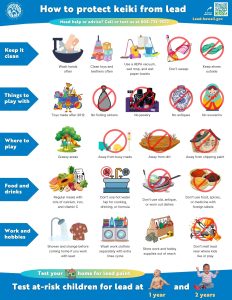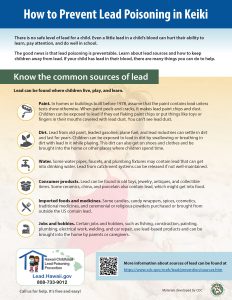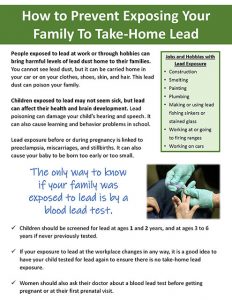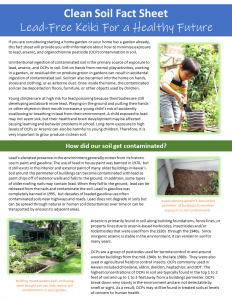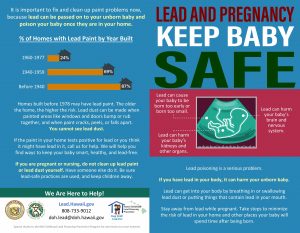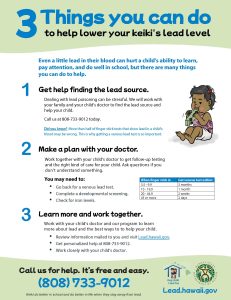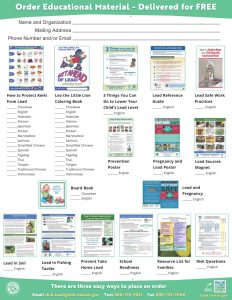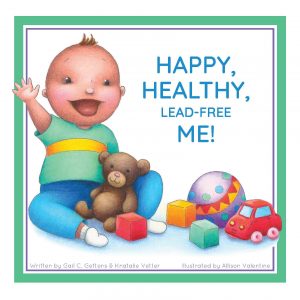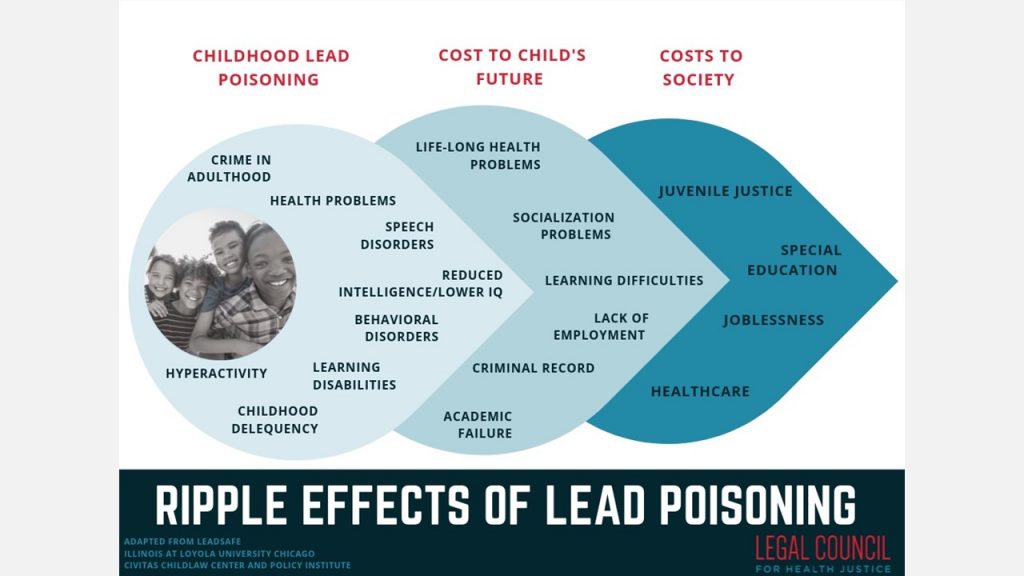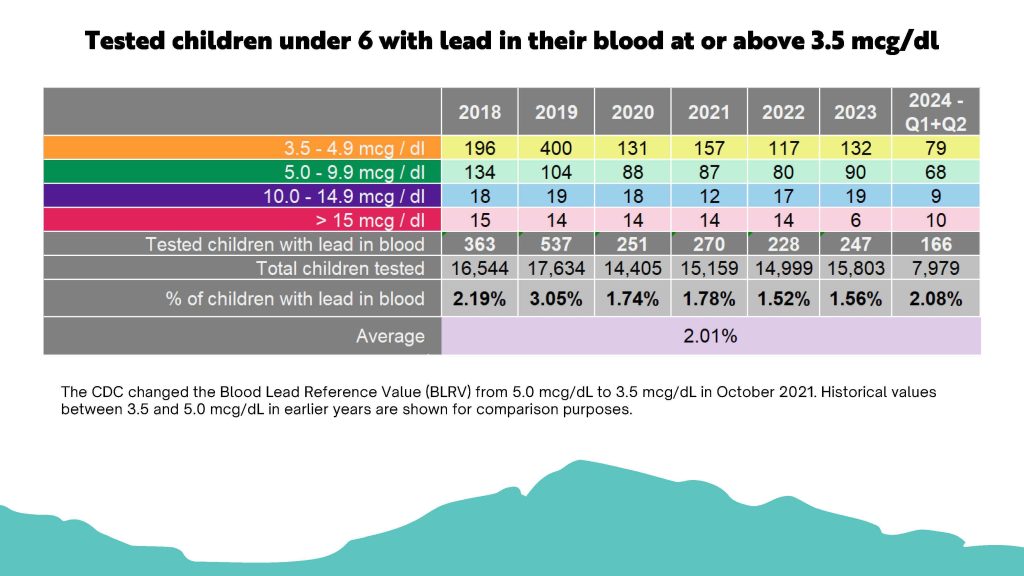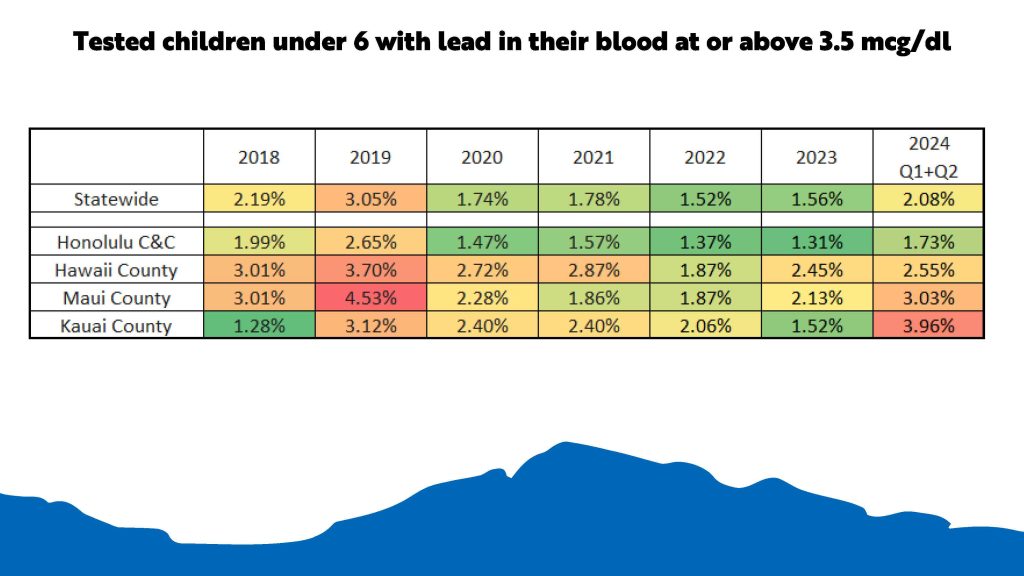
| Lead.hawaii.gov | LeadTest.hawaii.gov (healthcare providers) |
My Child has a Lead Test Above 3.5 mcg/dl. What Should I Do Next?
- If your child had a capillary test (from finger), make sure your doctor orders a venous test (from arm) to confirm your child actually has lead in his or her body. About half of capillary tests that show lead in a child’s blood are false positives. Getting a venous test is the only way to know for sure.
- Please fill out the Lead Safety Questions to find out how your child may be getting lead in his or her body. It is important to get help for your child as early as possible. Answering these questions is a great first step.
- Call us at 808-733-9012 for free help. We are here to walk you through everything. We can talk you through the Lead Safety Questions and fill them out for your while you are on the phone if it is easier for you. After these are complete, we can provide specific ways to protect your child. You can also review the How to Protect Keiki from Lead handout for things to do right away.
- With a confirmed venous test of at least 5 mcg/dl, your child is automatically eligible for free help from early intervention. This has been proven to help and is very important even if there are no current symptoms. Ask us about this when you call.
Why Keep Children Away From Lead?
Most children with lead poisoning don’t feel, look, or act sick, but even a little lead in a child’s blood can hurt their ability to learn, pay attention, and do well in school. You can give them a huge boost in school and for the rest of the lives by learning more and taking a few simple steps today. We are here to help the entire community (property owners, parents, grandparents, uncles, aunties, and more) keep children away from lead. Call or text us at 808-733-9012 for free help and advice. There are many important things you can do to help even if your child has already been exposed to lead.
Is There a Safe Level of Lead?
No, there is no known safe level of lead in blood. Even low levels of lead in the blood can cause serious health problems.
How Does Lead Get in the Body?
As children start to crawl and walk, they may put things with lead or lead dust into their mouths or put fingers into their mouths after touching things.
There are many types of lead sources in Hawaii like old paint, soil, house dust, jobs, hobbies, old toys, jewelry, cosmetics, antiques, souvenirs, fishing tackle, keys, dishes, food, spices, tobacco products, artificial turf, and water.
Paint is the most common source of lead in Hawaii. Lead was used in house paint until 1978. Lead dust from old paint falling apart can get on things inside and outside a building.
Soil can also have lead in it especially along busy roads or near the outside of buildings.
Spending time in a building where someone used to or currently smokes or vapes can also expose your child to lead and many other toxic chemicals.
Many people in Hawaii work with lead by making fishing tackle, using lead weights while fishing, doing home repairs and renovations, working on cars, using lead weights for scuba diving, working with lead batteries, working in construction, painting buildings or cars, being a plumber, doing roofing, doing soldering, doing welding, doing electrical work, working with guns, or working as an artist. Please keep all adult work and hobby supplies out of the reach of children, never melt lead near where children live or play, and learn how to work lead-safe to protect your family and friends.
Bringing lead home from work and hobbies can hurt your family and friends. If you are exposed to lead when pregnant, you may also expose your unborn child. This is because lead can cross the placental barrier. Lead can damage a developing baby’s nervous system and cause miscarriages and stillbirths. Even if you aren’t a child or pregnant, exposure to lead can cause serious health problems like anemia, kidney and brain damage, infertility in men and women, cancer, nerve and hearing damage, and heart disease. The risk of dying from a heart attack or stroke is two to five times more among people with higher blood lead levels. This is comparable to the increased risk from smoking, high cholesterol or high blood pressure.
How Can I Help My Child?
Limit access to all possible lead sources above. You don’t have to wait for your child to be tested to take action.
A simple blood test is the only way to know if a child has lead in their bodies. Children should get tested at 1 and 2 years of age, and later if never tested before. Testing is required and FREE with MedQUEST/Medicaid. Ask your child’s health care provider about a simple blood test. It is okay to test at other times too if you or your doctor thinks your child may have lead in their bodies.
It is also important to encourage children’s curiosity and desire to learn. Your child uses everyday experiences as a way to grow and understand the world. You can help your child learn and grow by spending one-on-one time with your child, doing fun developmental activities, and enrolling your child in an early childhood program. The Hi’ilei Developmental Screening Program offers FREE developmental screenings, information on community resources, and a list of fun activities to help your children grow and learn. Families can complete a developmental screening online or receive a questionnaire by mail.
Learn More About Lead
How Do I Make My Home Lead-Safe?
About 3 out of every 4 homes built before 1978 have lead-based paint. The older the home, the higher the risk. Lead dust can be spread when painted surfaces like windows and doors bump or rub together, and when paint cracks, peels, or is disturbed during renovations and repairs. You cannot see lead dust, but it can get on things inside and outside a building like shoes, toys, food, fingers, dirt, or almost anything. The Environmental Protection Agency (EPA) offers advice and tips on How to Make Your Home Lead-Safe.Any renovation, repair, or painting project in a pre-1978 home or building can easily create dangerous lead dust. The US Environmental Protection Agency (EPA) requires these projects to be performed by lead-safe certified contractors and has strengthened enforcement recently with record fines against violators including a $20 million fine in 2020.
Property owners, landlords, condo associations, childcare operators, real estate professionals, property management firms, and contractors all have responsibilities to understand.
Even if you are not planning any repairs, renovations, or painting, you still have responsibilities to inform and notify tenants and buyers about lead paint.
Anyone can report violations to the EPA here.
How Do I Find a Lead-Safe Contractor?
You can verify that a contractor is certified by checking the EPA website or by calling the National Lead Information Center at 1-800-424-LEAD (5323). You can also ask to see a copy of the contractor’s firm certification. Here are a few additional questions to ask.
- Ask if the contractor is trained to perform lead-safe work practices and ask to see a copy of their EPA training certificate.
- Make sure your contractor can explain clearly the details of the job and how the firm will minimize lead hazards during the work process.
- Ask what lead-safe methods will be used to set up and perform the job.
- Ask for references from at least three recent jobs involving buildings built before 1978, and speak to each personally.
- Always make sure the contract is clear about how the work will be set up, performed, and cleaned.
How Do I Test My Home For Lead?
There are two recommended ways to test your home for lead:
- Hire a Certified Inspector/Assessor: The best way to find out whether there are lead hazards in your home or yard is to hire a Hawaii State Certified Lead Inspector/Risk Assessor. HI-CLPPP has requested information from environmental firms to conduct and provide all services for combined Lead-Based Paint Inspection and Lead Risk Assessments (LBPI/LRA) using an XRF for Hawaii residents who are trying to prevent children from being exposed to lead. HI-CLPPP has heard from families that it is very difficult and time-consuming to get information and know what services they need. HI-CLPPP is providing this listing to encourage easy-to-access, transparent pricing information for families to get connected to the right services to protect children.
To figure out the base price in the table below, find the estimated size of your home or condo by searching for your exact address with unit number, city, state and zip code on an internet search engine. Additional costs (if required) along with tax will be added to the base price. Each firm has committed to:- Provide services that follow all State of Hawaii and Federal rules, requirements, and guidelines pertaining to combined Lead-Based Paint Inspections and Lead Risk Assessments (LBPI/LRA)
- Use a properly maintained and calibrated x-ray fluorescence (XRF) spectrum analyzer that is certified and designed to safely test paint, soil, and objects like keys, dishes, toys, and other consumer products as well a job and hobby supplies.
- Use a State of Hawaii certified lead-based paint inspector and lead risk assessor with a minimum of two (2) years of experience in conducting combined LBPI/LRAs where paint, soil, and objects are tested using an XRF.
The estimated price ranges listed in this table may be lower than is typically offered. Be sure to mention the DOH HI-CLPPP website when setting up any services and mention that you are relying on these price estimates to be correct. If you find prices are not accurate or if you want to add or remove your firm’s information, please email DOH.LEAD@doh.hawaii.gov.
This price listing is NOT an endorsement or recommendation, and the program does NOT warranty or guarantee any services provided by these firms. Factors other than price like skill and experience may vary from firm to firm. For more information on how these firms are regulated and to communicate any concerns, please see contact information at https://health.hawaii.gov/irhb/lead/Combined Lead-Based Paint Inspection and Lead Risk Assessment with XRF
EnvironMETeo
808-671-8383Muranaka
808-845-8822EnviroQuest
808-486-5881Base Costs (condo or house size) Less than 500 square feet $400 $400 - $600 $1,000 Between 500 and 1000 square feet $600 $600 - $800 $1,500 Between 1000 and 1500 square feet $700 $800 - $1000 $1,700 Between 1500 and 2000 square feet $800 $1000 - $1300 $2,000 Greater than 2000 square feet $900 $1300 and up $2500 and up Additional Costs Outside Core Honolulu Service Area Add $100 No additional charges Add $300 Neighbor Island Add travel costs plus 10% Add travel costs Add $1000 Dust Wipes and Lab Analysis
collected during inspectionAdd $40 per sample Add $41-$50 per sample Add $50 per sample Soil Sample and Lab Analysis
collected during inspectionAdd $45 per sample Add $46-$75 per sample Add $50 per sample Water Sampling and Lab Analysis
collected during inspectionAdd $65 per sample Add $48-$65 per sample Add $125 per sample
See the Lead Firm List for a directory of consultants and contractors registered with the State of Hawaii that can be hired to perform lead-related services like lead abatement and more limited repairs. Many firms listed in this directory are also certified to conduct LBPI/LRAs but they typically take paint samples and send them to a lab instead of using an XRF to test paint, soil, and objects at your home. - Collect Samples and Send Them to a Lab: If you decide to collect samples yourself, be sure to follow proper procedures outlined below. Lead test results are only as good as your testing procedures. The most important areas to test for lead are where your child spends a lot of time, where there is chipping paint or bare soil, and/or where you plan to renovate. Wash your hands and your tools with soap and water after each sample you collect. The samples will need to be sent to a laboratory for testing. We recommend a National Lead Laboratory Accredited Laboratory (NLLAP) for paint and soil and a Hawaii State Department of Health Certified Lab for drinking water. Call the laboratory you choose ahead of time for more specific instructions on collection methods, mailing guidelines, and documentation.
- Paint Samples: If you have different colored paint, it is a good idea to collect them as separate samples. Tape a clean, plastic bag beneath some paint you want to test. Use a clean scraper or knife to scrape at least the size of a quarter amount of paint into the bag. Be sure to scrape off all the layers of paint, not just the top coat. Try not to get any drywall or wood that is under the paint in the bag. Seal the bag and label it with where the sample was collected (i.e. Sample #1 – bathroom wall).
- Paint is considered hazardous lead-based paint when it tests greater than or equal to:
- 5,000 ppm (parts per million); or
- 0.5% by weight
- Paint is considered hazardous lead-based paint when it tests greater than or equal to:
- Soil Samples: Bare soil where your child frequents or plays should be the first to be tested. Use a large, clean trowel or spoon to scoop the top 1/2 inch of dirt (approximately 1 cup) into a clean, plastic bag. Collect the sample from the top of the soil that you want to test. If there are paint chips in the soil, these are okay to include in the sample. Seal the bag and label it with where the sample was collected (i.e. Sample #2 – playground). Watch this video for more information.
- EPA screening levels for lead in soil for residential areas are:
- 200 ppm (parts per million) if soil is the only source of lead exposure
- 100 ppm (parts per million) if there are multiple sources of lead exposure
- EPA screening levels for lead in soil for residential areas are:
- Water Samples: Two types of samples should be collected from each faucet used for drinking or cooking. The first sample is called a “first draw” sample and identifies whether there may be lead in the faucet fixture. To collect this sample, fill a 250 mL bottle with water from a faucet that has not been used for 8-18 hours. The second type of sample is called a “flush” sample and identifies whether there may be lead in the pipes. To collect this sample, let the same faucet run for at least 30 seconds and then fill another 250 mL bottle with water. Repeat this process for each faucet you are testing. If the “first draw” sample contains lead and the “flush” sample does not, it is likely that the faucet fixture is causing lead contamination. If both samples contain lead, it is likely that the pipes are causing lead contamination. The faucet fixture may also contain lead.
- The EPA has set the maximum contaminant level goal for lead in drinking water at zero, because lead is a toxic metal that can be harmful to human health even at low exposure levels. For public water systems, the EPA has set an action level of 10 parts per billion (ppb); but this is not a health-based standard.
- The American Academy of Pediatrics (AAP) recommends that school water fountains should not exceed 1 parts per billion (ppb), and the Food and Drug Administration (FDA) requires bottled water to be less than 5 parts per billion (ppb).
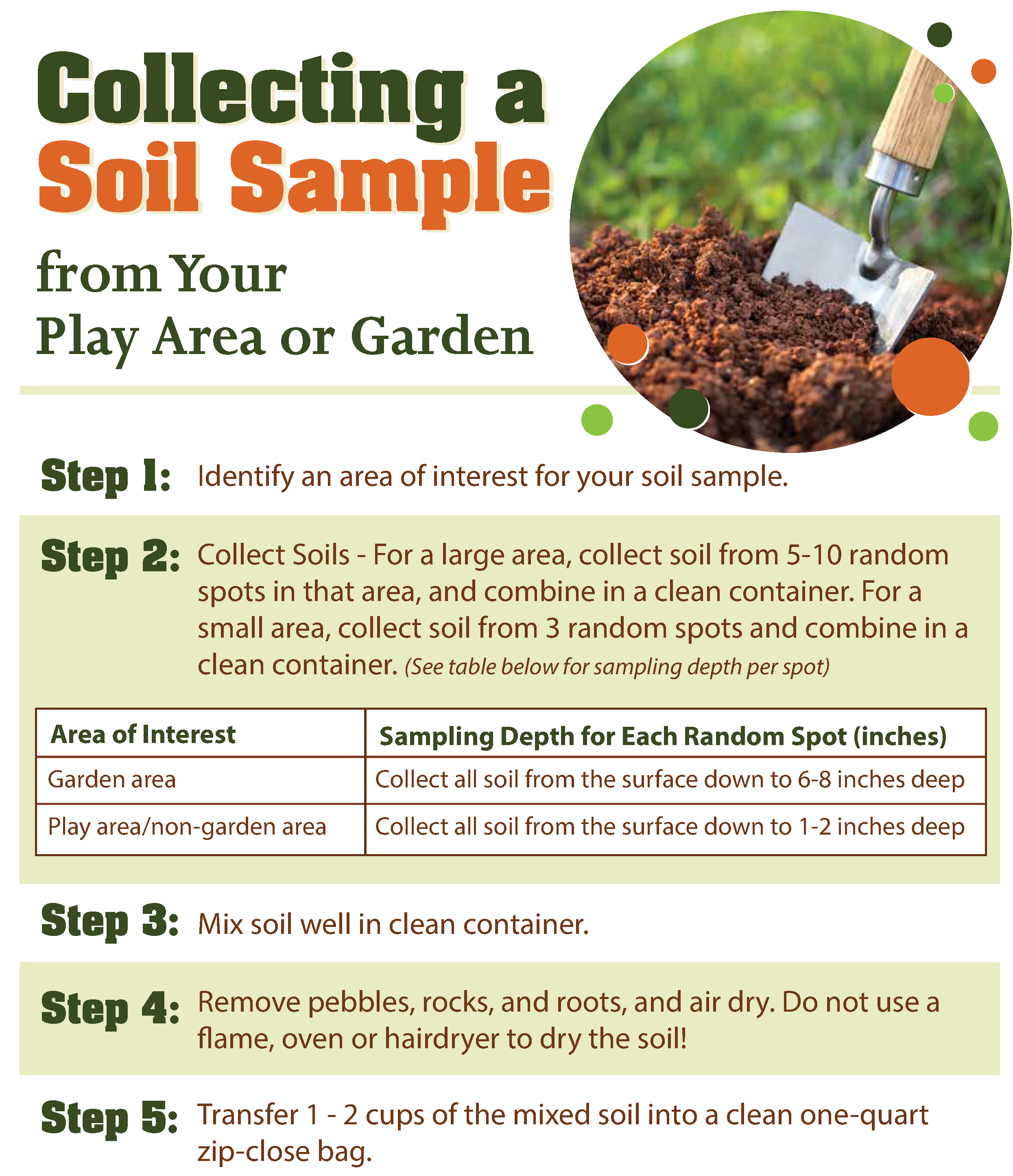
- Paint Samples: If you have different colored paint, it is a good idea to collect them as separate samples. Tape a clean, plastic bag beneath some paint you want to test. Use a clean scraper or knife to scrape at least the size of a quarter amount of paint into the bag. Be sure to scrape off all the layers of paint, not just the top coat. Try not to get any drywall or wood that is under the paint in the bag. Seal the bag and label it with where the sample was collected (i.e. Sample #1 – bathroom wall).
- Dust Samples: Dust samples require specific materials. Watch this video for instructions on how to collect a sample.
- EPA action levels for lead in dust are:
- Floors: 5 micrograms (mcg) per square foot
- Window Sills: 40 micrograms (mcg) per square foot
- Troughs: 100 micrograms (mcg) per square foot
- EPA action levels for lead in dust are:
Can I Use Lead Test Kits Bought Online?
Lead test kits are often available online and at local home improvement stores. They often contain swabs or wipes that change color when rubbed against a surface that contains hazardous levels of lead. If you use these tests, be sure to follow all instructions on the package and test all layers of paint by using a clean, very sharp knife to cut a small x-shape to expose all painted layers down to the bare surface before using the swab or wipe. Most of the available tests are NOT recognized by the EPA for providing accurate results. Home tests are not a good way to determine if products or your home is safe from lead. It is better to send sample to labs using the instructions listed above or have your home professionally inspected.
Free Help for Families and Caregivers
Hi’ilei Developmental Screening Program – Department of Health
Early Intervention (0-3 yrs) – Department of Health (automatic eligibility with venous level of 5 mcg/dl)
Special Education (3-5 yrs) – Department of Education
Help with Food and Nutrition (WIC) – Department of Health
Connect with Other Families – Family Hui
Problem Solving and Advice – The Parent Line
Legal Advice – Volunteer Legal Services Hawaii
Additional Information
Developmental Milestones – Centers for Disease Control and Prevention
Latest Recalls Foods, Cosmetics, and Medicine (FDA) Consumer Products (CPSC)
Information About Lead in Catchment Water – Safe Drinking Water Branch
Lead Hotline – National Lead Information Center
Lead Poisoning Information – Hawaii Poison Center
Call, Text, or Email Us for Free Help
The Hawaii Childhood Lead Poisoning Prevention Program (HI-CLPPP) is committed to helping the community:
- Prevent children from being exposed to lead.
- Identify children already exposed to lead so the source can be removed.
- Link families with recommended services.
Send mail
741 Sunset Avenue
Honolulu, Hawaii 96816
Send email
DOH.LEAD@doh.hawaii.gov
Call or text
808-733-9012
